| HOME | Translate |
|
| HOME | Translate |
|
|
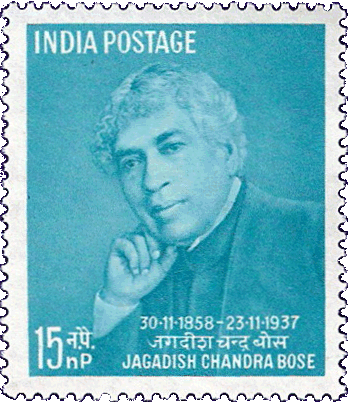 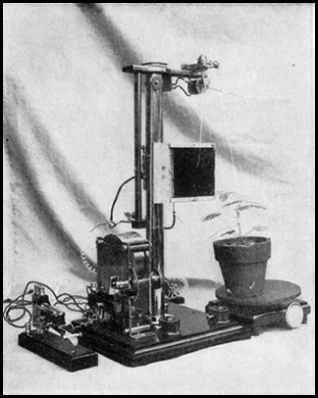 Indian
Scientist Sir Dr. Jagadish Chandra Bose Indian
Scientist Sir Dr. Jagadish Chandra Bose
(Nov. 30, 1858 – Nov. 23, 1937) Bose invented the Crescograph an electrical instrument that could measure the growth of a plant. In the photo (left) is a Crescograph monitoring a Mimosa Pudica (Sensitive Plant). He worked as a physicist, biologist, botanist, archaeologist and was a writer. He is recognized as the inventor of the first wireless detection device and for his discovery of millimeter length electromagnetic waves. India, in 1958 issued a commemorative postage stamp in honor of the centennial of his birth. (More about Dr. Bose) |
Modern
Electronic Crescograph
Designed
and Built by Randall Fontes to Measure Plant Movement
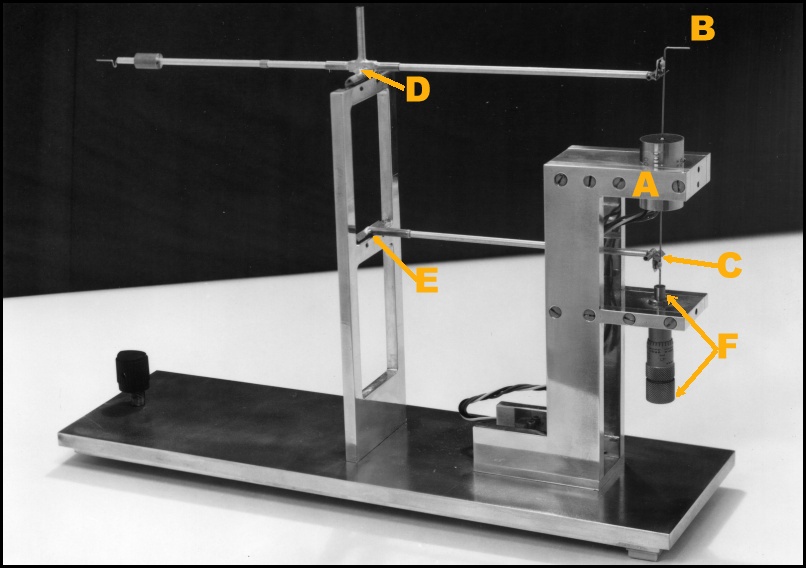
| THE
PLANT MOVEMENT DETECTOR ABOVE IS CAPABLE OF MEASUREMENTS
AS SMALL AS 1/1,000,000 OF AN INCH However, its normal operating range is from 1/1000 to 1/10,000 of an inch. The component which actually measures the movement is a differential transformer (A). Its movable core is hinged between points (B) and (C). Two lever arms hinged at points (D), (B) and (E), (C), form a parallelogram that holds the core centered within the opening of the differential transformer as it moves up and down. A micrometer (F) is used to adjust and calibrate the system. |
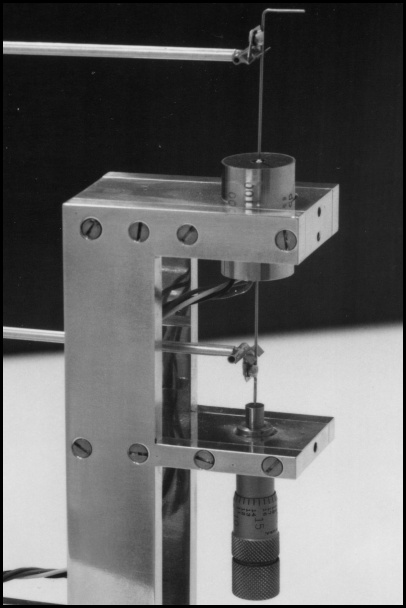
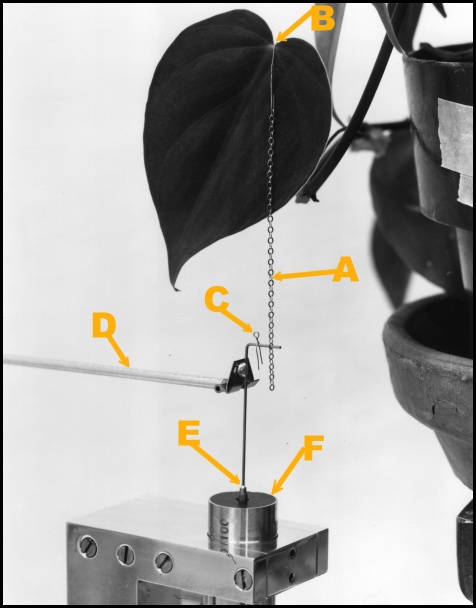
| HERE
A PHILODENDRON OXYCARDIUM LEAF IS ATTACHED BY A HOOK (B) AND GOLD CHAIN
(A) TO THE PLANT MOVEMENT DETECTOR
The lever arm (D) and transformer core (E) are held taut against the chain (A) by a 5 mg weight (C). A movement of the core (E) within the opening of the differential transformer (F) produces a change in the output voltage of the transformer which is proportional to the movement. |
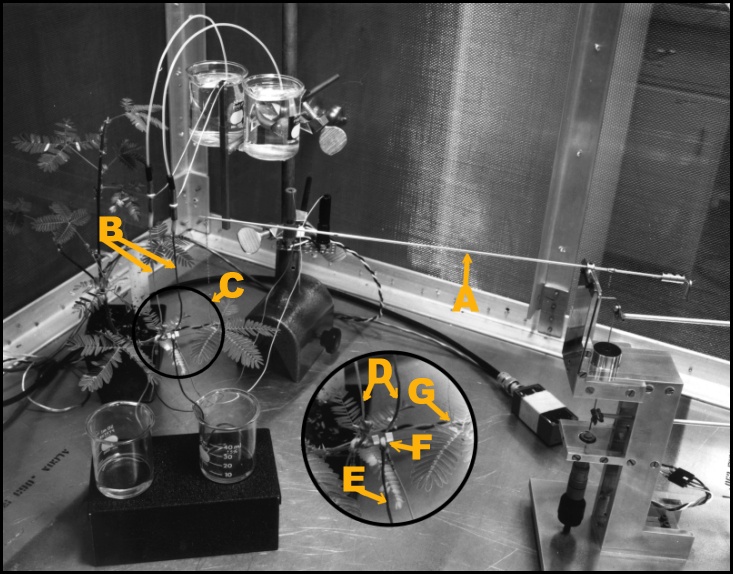
| THE
ELECTRODES SHOWN WITHIN CIRCLE (C) AND IN THE BLOW-UP TO THE RIGHT, WERE
DEVELOPED TO MONITOR ELECTRICAL POTENTIALS FOR LONG PERIODS OF TIME DEPENDABLY
WITHOUT DAMAGING THE PLANT
Water flows down from the upper beakers along polyester wicks (D), over the electrodes (F), onto a second set of wicks (E), and finally into the lower set of beakers. This process keeps the electrodes constantly wet and in electrical contact with the plant stem. The plant in this picture is a Mimosa Pudica or sensitive plant. In the previous picture, the philodendron leaf was shown supporting the chain which was attached to the movement detector directly, while in this figure the chain is supported by the lever arm (A). This has been done, in order to keep the weight of the chain from pulling down on the delicate leaf. The Mimosa Pudica moves such relatively large distances (1 or more inches) in such short periods of time that a 20 to 1 reduction lever arm (A) must be used just to keep its movements within the range of the movement detector. |
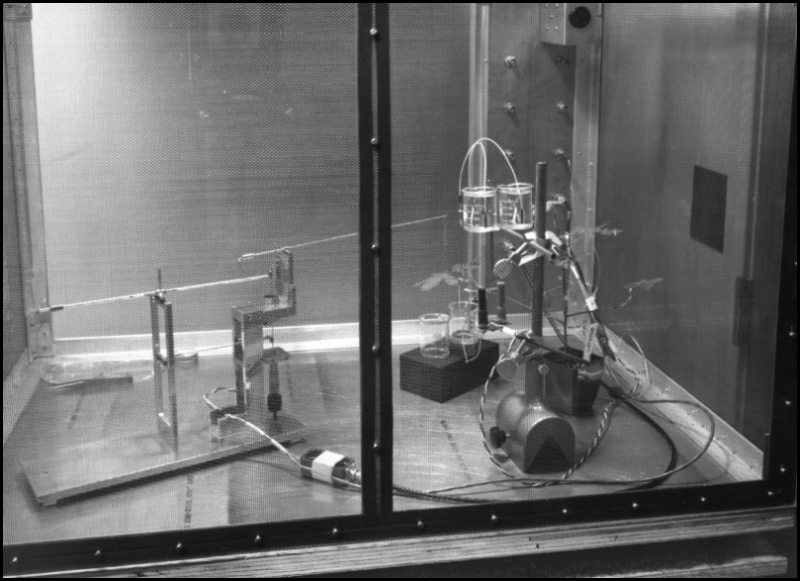
| THE
INSTRUMENTS SHOWN WITHIN THE COPPER SCREEN AND PLEXIGLAS CAGE ARE SHIELDED
FROM ELECTROMAGNETIC RADIATIONS, ELECTROSTATIC EFFECTS, AND AIR CURRENTS
The cage itself is mounted on two 1-inch thick plywood boards with rubberized horse hair between them, as can be seen in the extreme lower right-hand corner. The boards are in turn resting on four special shock-absorbing rubber feet, which rest on a Plexiglas stand sitting on a concrete floor. |
| R.Fontes@comcast.net | |

|
By: H. E. Puthoff and R. Fontes Electronics and Bioengineering Laboratory S.R.I Project 3194 (Task 3) November 1975 
Randall Fontes, M.A. worked with the twice nominated physicist for the Nobel Prize Dr. Harold E. Puthoff and Russell Targ at Stanford Research Institute (SRI International): CIA-Initiated
U.S. Government
|

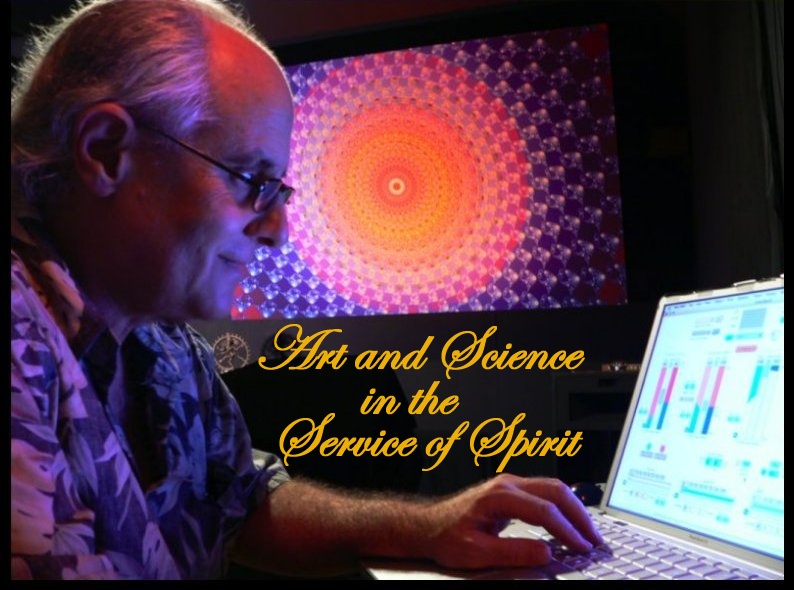
|